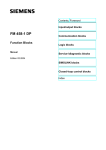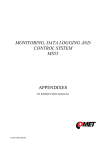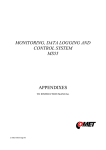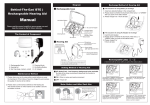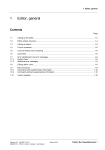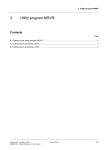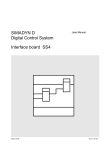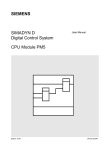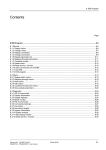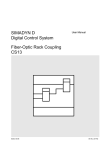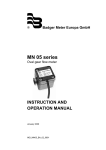Download "user manual"
Transcript
23 Download 23 Download The utility download is designed to load on-line configured data or complete programs directly into the memory board of a P32 processor (not into DRAM). The transmission procedure can only be started with STRUC G in the basic dialog shell (menu item ‘PROG. / Download’). A rack reset can also be activated for a rack. The loading procedure can be implemented via the communication protocols DUST1 or SINEC H1. All utility download activities are controlled via job requests, that arrive via ‘‘its’’data interface (corresponds to the CTS and US connector specifications). The data to be loaded is also transmitted via this interface. The download utility is made available by the function block ‘‘LPN’’. This block must therefore be configured on each processor, upon which its memory board is to be loaded on-line. 23.1 Hardware All RAM memory modules MS55 and Flash memory modules MS5 from release ‘B’(coding 81133--20 on the side of the board) can be loaded. Older releases of the MS5 modules (coding 81113--20 or 81123--20 on the side of the board) cannot be loaded via a download procedure. They must be programmed off-line. The reason for this is, that Flash modules must first be deleted before they can be loaded. The delete process must be implemented block by block for the download procedure (only possible from the release status ‘B’). Due to this additional delete process, the loading time for a Flash module takes correspondingly longer than for a RAM module (also review the chapter ‘System Loading’). 23.2 Function Block LPN The function block ‘‘LPN’’has one interconnection for a data interface. It may be configured only once for each processor module. Multiple configuring will be detected and leads to an entry into the communication error panel (‘C’ in the 7 segment display) and an error code at the output YTS. The CTS connector designates the board and the interface, via which the user is connected. A channel name is specified at the US connector. An addressee number is specified in addition for serial links. The syntax is dependent upon the type of utilized links. These two connectors are INIT connectors; they are only evaluated during system start-up. Changes to the connector values are ineffectual during running operation. The block is enabled (EN=1) or disabled (EN=0) at the EN connector. The QTS connector indicates the block status (logical 0 = ‘‘Fault’’, logical 1 = ‘‘No Fault’’). The output YTS contains a detailed error code defining the cause of the communication error (see User Manual ‘General Diagnostics’, chapter 3, Communication Error Diagnostics P32). Siemens AG 465 980.7107.22 SIMADYN D Configuring Manual Communication Release 04.96 23--1 23 Download Example: 1[ms] D — D— 16[ms] D — D— D— Left-Hand Edge Strip Configuring with STRUC T1 T2 T3 T4 T5 DOWNLD 10T3 LPN ’ CS7.X01’ -- CTS ’ CHANNEL.8’-- US 1 -- EN B1 QTS -CR-O2 YTS -NS-B1 R x D Right-Hand Edge Strip Remark: This example shows the LPN sampling time to be 16ms. This dimensioning reserves a maximum of 12.5% processor capacity for the download utility (2ms/16ms=12.5%). Review the section ‘‘System Loading’’for more detail. 23.2.1 Channel Setting The transmit and receive channels operate in the handshake mode. This guarantees that no telegram will be lost. 23.2.2 Request Job Processing A request job is always accompanied with a reply telegram. The request and reply processing is handled by the basic dialog without user interaction. The user only actives the download procedure and receives the acknowledge upon completion, whether the procedure has been handled without error or terminated with an error. During the loading procedure, the user is only informed of the current loading progress in %, in an info window. 23.3 System Loading The actual processing of the download utility is implemented in the sampling time configured for the block. The download block has a certain processing time available in the utilized sampling time and is a maximum of 2ms. The relationship between this time and the utilized sampling time determines the processor capacity available and therefore the system loading. Example 1: Selected Sampling Time = 64ms (Loading procedure via DUST1) Every 64ms, a maximum of 2ms is reserved for the download utility Maximum system loading = 2ms / 64ms = 0.03125 = 3.125% Example 2: Selected Sampling Time = 16ms (Loading procedure via SINEC H1) Every 16ms, a maximum of 2ms is reserved for the download utility Maximum system loading = 2ms / 16ms = 0.125 = 12.5% The LPN block normally processes one job request per clock period. This signifies for loading, that a loading telegram is received, programmed in the memory board and a reply telegram returned per clock period. If the reserved processing time is not completely utilized, since for example no job request for processing has been made, then it is made available to the system. Therefore when no download procedure takes place, then this system loading does not occur. The loading procedure into RAM modules (MS55) utilizes only a fraction of the maximum processing time of 2ms (< 0.1ms); whereas writing to Flash EPROM (MS5) will require programming times of ² 1.2ms for a loading telegram. This must be taken into account for the loading procedure, in order not to overload the processor. 23--2 Release 04.96 Siemens AG 465 980.7107.22 SIMADYN D Configuring Manual Communication 23 Download 23.4 Response to Faults A differentiation into two cases is made when a fault occurs: The block terminates a currently running download procedure, it is set to the status OFF and additionally generates a communication error (multiple configuring, communication error). The block terminates only the current download procedure with a corresponding error message (i.e. memory board write protected, write error, etc.) at the shell (error window in basic dialog) and is reset to the original status (block remains in the status ON). 23.5 Special Configuring Remarks The download can also be implemented via differing communication interfaces. The general configuring remarks regarding the specifications to be made at the connector US (address connector) can be reviewed in the User Manual STRUC G, chapter 8, IBS G configuring and the User Manual Communication (for the individual protocols). 23.5.1 DUST1 Loading via the protocol DUST1, requires the block LPN to be configured with a sampling time of 64ms < Ta < 128ms. This permits a loading telegram to be received, programmed and replied to at each sampling cycle. Shorter sampling times are not recommended, since the telegrams cannot be made available any quicker via the DUST1 with 19.2 k baud. Loading time for 500 k byte (19.2 k baud): approximately 7 minutes. 23.5.2 SINEC H1 The block LPN should be configured with a sampling time of 12ms < Ta < 20ms when the download is to be implemented via the SINEC H1 bus. A loading telegram can then be received, programmed and replied to with each sampling cycle. Shorter sampling times here will also only increase the system loading and not raise the loading procedure performance, since the loading telegrams cannot be made available by the configuring computer any faster. Loading time for 500 k byte: approximately 1.5 minutes. 23.5.3 Networks The loading procedure can, of course, also be implemented via a network (both routing and peer to peer). Review the User Manual Communication, chapter 25, Network for the corresponding configuring details. The loading times are increased according to the number of network nodes utilized, since the telegram run times for loading and reply telegrams will be correspondingly raised. An optimization has been implemented (several telegrams running on the path simultaneously), in order to keep these dead times as small as possible. Siemens AG 465 980.7107.22 SIMADYN D Configuring Manual Communication Release 04.96 23--3 23 Download 23--4 Release 04.96 Siemens AG 465 980.7107.22 SIMADYN D Configuring Manual Communication




